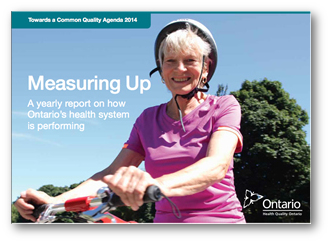 Health Quality Ontario’s (HQO) new report, Measuring Up, suggests Ontarians are living longer and feeling better than ever about their health but, that many have unhealthy lifestyles. For example, 45 percent of Ontarians are inactive and almost 18 percent are considered obese. The report also shows that in many areas, Ontario’s health system is performing better than it was five and 10 years ago. Nevertheless, there are variations in health and access to care depending on where people live in the province. Ontarians in the north, for example, have much higher rates of obesity and smoking, and twice the rate of premature avoidable death than those in some other parts of the province. This translates to a five-year difference in life expectancy between the healthiest region in the province and the north.
Health Quality Ontario’s (HQO) new report, Measuring Up, suggests Ontarians are living longer and feeling better than ever about their health but, that many have unhealthy lifestyles. For example, 45 percent of Ontarians are inactive and almost 18 percent are considered obese. The report also shows that in many areas, Ontario’s health system is performing better than it was five and 10 years ago. Nevertheless, there are variations in health and access to care depending on where people live in the province. Ontarians in the north, for example, have much higher rates of obesity and smoking, and twice the rate of premature avoidable death than those in some other parts of the province. This translates to a five-year difference in life expectancy between the healthiest region in the province and the north.
Each year, HQO’s report assesses thehealth of Ontarians and how the health system is performing. For the first time, this year’s report uses concise indicators called, the Common Quality Agenda, to monitor the quality of health care in Ontario. This set of indicators encompasses a range of statistics, such as the proportion of Ontarians who smoke and wait times for particular surgeries. The indicators also span the health sector from primary to hospital care and home care to long-term care..
Measuring Up also features stories from patients, providers and caregivers, who offer perspectives on the health system and provide insights that go beyond the numbers and charts.
Highlights from Measuring Up
- Ontarians are living longer – and feeling better about their health – than ever. Life expectancy has improved to 81.5 years, s second-highest among the provinces behind BC. When it comes to how we think about our health, two-thirds of Ontarians rate their health as excellent or very good, more than in most other peer countries in the world.
- Many Ontarians have unhealthy lifestyles. Nearly half of Ontarians are inactive, and one out five smokes. Although these rates are better than the Canadian average, there is clearly substantial room for improvement.
- Most Ontarians are not able see their primary care provider promptly when they are sick. Nine out of 10 Ontarians have a regular primary care provider which is good news, however 60 percent are unable to see their primary care provider on the same day or next day when they are sick. More than half of Ontarians also have difficulty accessing primary care on evenings or weekends.
- Wait times for surgery and emergency department lengths of stay are improving, but some people are still waiting longer than provincial targets. More patients are receiving urgent cancer surgeries and cardiac procedures within the target wait time, but there is still room for improvement. Patients who need emergency department care are being discharged from the emergency department more quickly than they were several years ago, but targets have still not been achieved.
- Most home care patients receive care within the target wait time, but people in some parts of Ontario wait longer than others. The majority of Ontario home care patients appear to receive their first nursing care visit and personal support services within a five-day target, but depending on where they live, they may wait longer than others.
- Wait times for long-term care in Ontario are improving, but there is a lot of variation across the province. Median wait times have improved over the last four years. Ontarians waiting for a space in a long-term care home can expect to wait two to four months, but it varies widely depending on where they live.
- Parts of the health system need to be better coordinated. Patients often have trouble receiving care across the different parts of the health system. On a typical day in Ontario, one in seven hospital beds designated for acute care is occupied by a patient who is well enough to receive care in another setting. More than half of patients who were treated in a hospital for conditions requiring follow-up do not see a doctor within seven days of leaving hospital.
For more information, vist the Health Quality Ontario’s website.